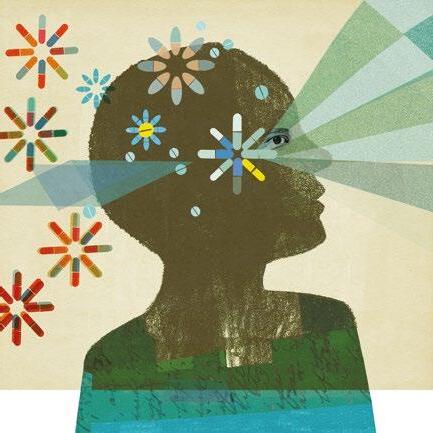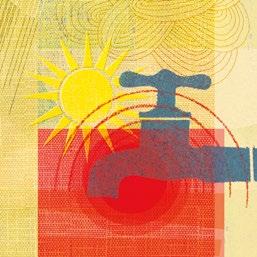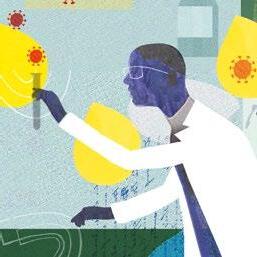Making the Impossible, Possible

For more than 20 years, I have been deeply focused on the vast inequities in global health and development—and all the ways we can make the world a healthier, safer, and fairer place for everyone.
Millions of children die each year from preventable diseases that people in wealthy countries don’t have to worry about. Hunger and malnutrition are prevalent in far too many places. Hundreds of millions of people around the world experience extreme poverty.
Challenges like these can seem intractable. But the good news is that the world made historic progress against disease and poverty in the first two decades of this century—and we’re on the cusp of so many more advances, with the help of good science, smart people, and sustained investment.
In global health, innovation and research and development (R&D) go hand in hand. Technology keeps evolving, and scientists are constantly developing better tools and techniques to address health challenges. But R&D is expensive, and it takes many years to turn ideas into safe, affordable, and accessible products that can save lives. Not every smart idea will work. Those of us who support this work accept the risk because every pursuit gets us closer to workable solutions.
I believe that the smartest experts should be focused on making the world more equitable and healthier. It’s why the Gates Foundation invests in big ideas that have the potential to make this goal possible for children and families around the world. Ingenuity, persistence, and collaboration are key to that progress.
No transformational breakthrough happens in a silo. Partnership is our greatest strength. In this report, you’ll see how Gates Philanthropy Partners has helped innovators and big thinkers take chances and make progress toward a healthier, more equitable world.

Thank you for standing with us to achieve these goals, together.
Bill Gates
January 1, 2022—December 31, 2022
The pandemic reached its third year in 2022—but a light shone at the end of the tunnel. Thanks to you, Gates Philanthropy Partners followed through on our grant commitments to advance COVID-19 treatments and vaccines, while making new investments in global health and beyond that benefit us all.
OUR COLLECTIVE IMPACT
42
$48.8M 42+ 733
partners
2022 Outgoing Grants
Combating COVID-19: Protecting the Most Vulnerable
$2,050,031
Combating COVID-19: Therapeutics Accelerator
$19,298,842
Combating COVID-19: Vaccines
$7,545,802
Disease Elimination & Eradication
$799,410
Economic Mobility & Opportunity
$800,000
Empowerment & Opportunity
$100,000
Global Health Innovation
$17,771,947
Newborn & Child Health
$150,000
Preventing the Next Pandemic
$250,000
2016 —2022
Together, we have distributed more than $241.1 million in grants to 107 organizations. Health has always been a leading focus of our grantmaking. Good health provides the foundation for a meaningful life; in all that we do, we seek to make it available to everyone, regardless of age, gender, income, or geography.
Outgoing Grants (2016—2022)
Combating COVID-19: Diagnostics
$3.4M
Combating COVID-19: Protecting the Most Vulnerable
$8.1M
Combating COVID-19: Therapeutics Accelerator
$107.3M
Combating COVID-19: Vaccines $30.7M
Economic Mobility & Opportunity Empowerment & Opportunity Disease Elimination & Eradication
$12.1M $3.6M
Global Health Innovation
Newborn & Child Health Preventing the Next Pandemic
U.S. Education
$69.6M $1.3M $1.4M $250K $3.4M
grantee partners leading 44 projects distributed to grantee partners across 9 areas of focus countries around the globe served by grantee partners donorUnder Pressure: Where is the Oxygen?
It’s 2022 and the third year of the COVID-19 pandemic. At the Gates Foundation, Erin Hulme Oceguera and her husband receive a text message from their family in Mexico: Do you know which hospitals have oxygen?
This is not an unusual message for families experiencing medical crisis due to COVID-19. For months, this same question crisscrosses the globe in texts, phone calls, and urgent conversations. While doctors prescribe oxygen to treat severe cases of COVID-19, in many cases, oxygen is simply not available.
In low- and middle-income countries, the response to the pandemic was built on health systems riddled with cracks in their foundations. The problem with oxygen was just one in a long line of similar problems. The weight of the pandemic exposed huge gaps and inequities in how healthcare is delivered around the world—and


whether it can be delivered at all. But, sometimes, with great pressure comes great opportunity.
Together with the Gates Foundation, Gates Philanthropy Partners’ pandemic response focused on fixing what was broken, while also supporting new tools to fight COVID-19. With your support, Gates Philanthropy Partners invested in manufacturing syringes in Africa, developing medicines that could treat any coronavirus infection, and building robust emergency response systems to stop outbreaks before they spread. These forward-looking investments not only tackled COVID-19 but make it possible to tackle other diseases as well.
Fixing What’s Broken
So, back to the original question about oxygen, an essential medicine and a critical treatment for many illnesses. Where was it? The truth is that oxygen was missing even before the COVID-19 outbreak.
Medical oxygen is produced and distributed through an interconnected web of generation equipment, piping systems, delivery infrastructure, and clinical tools. A breakdown at any stage in such a system—a cracked hose, a broken valve, a missing connector—means that patients do not get the oxygen they urgently need.
Before the pandemic, only 10% of medical facilities in many low- and middle-income countries owned any medical oxygen equipment; of that equipment, only 50% was functional. With rising demand during the pandemic, hospitals struggled even more to keep oxygen flowing from broken and poorly maintained plants. This hidden emergency, happening in clinics and hospitals every day, suddenly became the focus of international attention in these last few years.
With Senior Program Officer Doug Call at the helm, Gates Philanthropy Partners is supporting a trio of experienced organizations—PATH, CHAI, and Build Health International (BHI)—to correct this inequity for the future. For BHI, the plan is simple: find the

A Deep Breath
The path out of the pandemic does not follow a straight line. COVID-19 has magnified inequities that have existed for years. The way forward is not only to forge ahead with innovation, but to look closely at where years of neglect stand in the way
facilities that need repair and fix them. A team of engineers and mechanics paired with health professionals travels across 15 countries in Africa, repairing broken oxygen-generating plants and training local technicians on how to make the fixes and maintain the facilities.
With repairs to date, the amount of oxygen available across those countries can serve 10,000 patients a year. This is good news for everyone, especially families with sick children. Hypoxemia, or low blood oxygen, affects almost one-quarter of sick newborns and more than one in six hospitalized children. Improved oxygen systems can reduce the number of children who die in the hospital by 25%.
In tandem, PATH and CHAI are helping 14 countries plan and execute national oxygen strategies to address COVID-19 and other causes of hypoxemia, including child pneumonia. These countries will now be able to make more informed decisions to secure and finance the oxygen equipment they need. To improve hypoxemia diagnosis and the use of oxygen therapy more broadly, PATH and CHAI will support them as they deploy new equipment and build capacity to monitor and maintain it for the long-term—a win-win at every level.
of better health—and correct those gaps, as well. It’s a forward-looking approach that means the difference between a deep breath and a gasp for air in managing future emergencies.
The Art (and Science) of Taking Chances
Breakthroughs can come from anywhere. In brilliant minds across the globe sit smart early-stage concepts. Exceptional ideas that—given time, space, and a little funding to experiment—can turn into bold, new solutions that help save and improve lives.
In 2003, the Grand Challenges initiative launched with a question: How can we seek out new thinking to old problems in global health? For the last 20 years, investigators have answered this call for innovation—to think beyond the conventional, test their ingenuity, and take outside-the-box risks to see what more is possible.

This push for bold ideas is built for speed, for going further and faster together. Each challenge fosters collaboration at a global scale, bringing together researchers and funders who experiment with how to address some of the same issues from different angles.
To date, Grand Challenges has awarded 3,640 grants to researchers in 118 countries, putting those who know the problems best—namely, the communities and countries most affected by health and other inequities—in the driver’s seat to explore new solutions.

When we take a chance on science and new solutions, there’s no telling what we can accomplish.
Because sometimes, all a wild idea needs… is a chance.
Seeking Visionary Ideas
In 2022, Gates Philanthropy Partners took a chance on 22 potentially groundbreaking projects. Here, we spotlight a few of these projects tackling better health through sanitation and sequencing.
Thinking Differently about Toilets and Sanitation
Many people take a flush toilet and an effective sewage system for granted. However, communities without these systems face serious health risks from their drinking water as a result. How many people don’t have access to adequate sanitation? 3.6 billion, to be specific—nearly half the world’s population.
New technologies, delivery models, and policies can save lives and stop diseases at scale—even in geographies without running water, sewers, or central systems. Because of Grand Challenges, researchers are thinking differently about decades-old problems to make safely managed sanitation a reality for everyone.

Paving New Pathways to Clean Water
Too many families around the globe live in residences without running water. Instead, they grapple with public water infrastructure that is often poorly maintained and insufficient, if it is available at all. The University of Massachusetts at Amherst is rethinking ways to make water cheaper and accessible closer to home. Among their creative proposals: allowing low-income families to sign up for subscription services at local kiosks that would provide dependable water delivery directly to their homes. This idea would make access to safe water more convenient and reliable for communities in urban and rural areas alike, particularly across Asia and Africa.
Testing Water and Waste for Bacteria—Without the Lab


To ensure water is safe to drink or that waste is safe to discard requires the right tools to test for bacterial contamination. This process has been far from fast and easy. Samples must be taken and transported to labs for analysis, leaving communities vulnerable to unsafe water supply while they wait for results.
South Korean start-up PiQuant is cutting the lab out of the process with a low-cost scanner. Their device uses light, a water sample, and a computer algorithm to deliver instant, clear results. Your support is helping them refine the process to test treated water supplies, which, if successful, could have a huge impact on community health around the world.
Mapping Disease from the Inside Out
It’s not enough to know how a disease works and moves through populations of people; we also need to understand the organism that causes it, down to its genetic material. Discovering new pathogens unlocks new information…but how does that data get used? How do scientists track a pathogen’s evolution, no matter where it’s found?

The Gates Foundation, Chan Zuckerberg Initiative, Chan Zuckerberg Biohub—and you—have forged a partnership that marries our resources and mentorship with the talents and drive of scientists from low- and middle-income countries to build their local capacity to save lives. Since 2018, 21 investigators have been given sequencing tools and interactive learning opportunities to track and analyze diseases back home.
Hunting Feverishly for Better Diagnosis

Peggy Lee’s song “Fever” might have made fevers famous, but for millions of people, what causes them isn’t always so clear. A fever is the body’s natural reaction to an illness. But which one? For nearly half of patients suffering from fever, the cause is unknown. If we can become faster and better at diagnosing diseases, improved treatment outcomes should follow.
Sequencing is the key to mapping the unknown causes of fever and finding patterns across places and populations. One Grand Challenges project aims to understand malaria and other fever-causing illnesses in Southeast Asia, drawing data from sites in Bangladesh, Laos, and Thailand. Another project is exploring pathogens causing meningitis in Côte d’Ivoire, Guinea, and Mali. Together, their findings will help get patients a true diagnosis—and expand sequencing capacity to transform global health.



